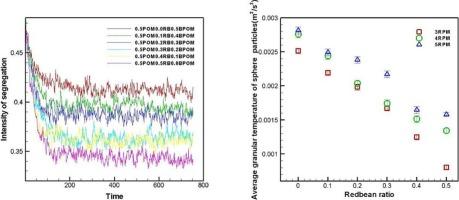Experimental investigation of the influence of non-spherical bead ratios on size-induced segregation in ternary granular systems
IF 4.6
2区 工程技术
Q2 ENGINEERING, CHEMICAL
引用次数: 0
Abstract
Granular segregation plays a vital role in both industrial applications and geophysical processes. This study examines the influence of non-spherical particle ratios on size-induced granular segregation in a rotating drum. High-definition DV and high-speed cameras were used to capture particle motion, while an image-processing method and particle-tracking technology were employed to measure key parameters, including average velocity, granular temperature, dynamic angle of repose, and segregation intensity. The results indicate that incorporating non-spherical particles mitigates size-induced segregation. Specifically, the final steady-state segregation intensity decreases as the proportion of non-spherical particles increases in a ternary granular mixture. Additionally, a higher ratio of non-spherical particles leads to an increase in the dynamic angle of repose. Furthermore, both the average velocity and granular temperature decrease with increasing non-spherical particle ratios due to the influence of grain shape on segregation behavior.

三元颗粒体系中非球形粒比对粒径诱导偏析影响的实验研究
颗粒偏析在工业应用和地球物理过程中起着至关重要的作用。本研究考察了非球形颗粒比对旋转滚筒中尺寸诱导的颗粒偏析的影响。采用高清DV和高速摄像机捕捉颗粒运动,采用图像处理方法和颗粒跟踪技术测量平均速度、颗粒温度、动态休歇角和偏析强度等关键参数。结果表明,非球形颗粒的掺入减轻了尺寸引起的偏析。具体来说,随着三元颗粒混合物中非球形颗粒比例的增加,最终稳态偏析强度降低。此外,非球形颗粒比例的增加导致动态休止角的增加。此外,由于晶粒形状对偏析行为的影响,平均速度和颗粒温度随非球形颗粒比例的增加而降低。
本文章由计算机程序翻译,如有差异,请以英文原文为准。
求助全文
约1分钟内获得全文
求助全文
来源期刊

Powder Technology
工程技术-工程:化工
CiteScore
9.90
自引率
15.40%
发文量
1047
审稿时长
46 days
期刊介绍:
Powder Technology is an International Journal on the Science and Technology of Wet and Dry Particulate Systems. Powder Technology publishes papers on all aspects of the formation of particles and their characterisation and on the study of systems containing particulate solids. No limitation is imposed on the size of the particles, which may range from nanometre scale, as in pigments or aerosols, to that of mined or quarried materials. The following list of topics is not intended to be comprehensive, but rather to indicate typical subjects which fall within the scope of the journal's interests:
Formation and synthesis of particles by precipitation and other methods.
Modification of particles by agglomeration, coating, comminution and attrition.
Characterisation of the size, shape, surface area, pore structure and strength of particles and agglomerates (including the origins and effects of inter particle forces).
Packing, failure, flow and permeability of assemblies of particles.
Particle-particle interactions and suspension rheology.
Handling and processing operations such as slurry flow, fluidization, pneumatic conveying.
Interactions between particles and their environment, including delivery of particulate products to the body.
Applications of particle technology in production of pharmaceuticals, chemicals, foods, pigments, structural, and functional materials and in environmental and energy related matters.
For materials-oriented contributions we are looking for articles revealing the effect of particle/powder characteristics (size, morphology and composition, in that order) on material performance or functionality and, ideally, comparison to any industrial standard.
 求助内容:
求助内容: 应助结果提醒方式:
应助结果提醒方式:


